
The Project Gutenberg EBook of Hospital Sketches, by Robert Swain Peabody This eBook is for the use of anyone anywhere at no cost and with almost no restrictions whatsoever. You may copy it, give it away or re-use it under the terms of the Project Gutenberg License included with this eBook or online at www.gutenberg.net Title: Hospital Sketches Author: Robert Swain Peabody Release Date: February 15, 2011 [EBook #35289] Language: English Character set encoding: ISO-8859-1 *** START OF THIS PROJECT GUTENBERG EBOOK HOSPITAL SKETCHES *** Produced by Chris Curnow, Emmy and the Online Distributed Proofreading Team at http://www.pgdp.net (This file was produced from images generously made available by The Internet Archive)


Acknowledgments are made to Messrs. Charles Scribner's Sons for permission to use a passage from Edith Wharton's Fighting France and to The Macmillan Company for the use of the poem "Aedh wishes for the Cloths of Heaven," by W. B. Yeats.
| INTRODUCTION | ix | |
| VIEW FROM THE HOSPITAL TERRACE | 1 | |
UPTHORPE-CUM-REGIS | ||
| I. | The Minster and the Meadows | 3 |
| II. | The Church Yard | 7 |
| III. | The Village | 11 |
| IV. | The Hall | 15 |
| V. | Trong's Almshouses | 19 |
RANCONEZZO | ||
| VI. | The Town and the Lake | 23 |
| VII. | Piazza Garibaldi | 27 |
| VIII. | Piazza Cavour | 31 |
| IX. | North Door of the Duomo | 35 |
| X. | Interior of the Duomo | 39 |
| XI. | The Villa of the Cardinal Schalchi-Visconti | 43 |
| XII. | Santa Prassede, the Cardinal's Church | 47 |
| XIII. | The Cloisters of Sta Prassede | 51 |
| XIV. | The Tomb of the Cardinal in Sta Prassede | 55[viii] |
ROCHER-ST.-POL | ||
| XV. | The Town and the River Merle | 59 |
| XVI. | La Grande Rue and La Place de la République | 63 |
| XVII. | L'escalier de Jacob | 67 |
| XVIII. | Le Parvis de Ste Frédigonde | 71 |
| XIX. | Interior of the Church of Ste Frédigonde | 75 |
| XX. | Sacristy Steps in the Church of Ste Frédigonde | 79 |
| XXI. | The Château Beaumesnil | 83 |
| XXII. | La Tour de la Dame Blanche | 87 |
AEGINASSOS | ||
| XXIII. | The Temple and the Forum | 91 |
| XXIV. | The Temple and the Forum | 95 |
However that may be, if he is ever immured for many weeks in a great hospital, he will be surprised to find how many are the similarities between[x] its life, its discipline and its atmosphere, and those of the great monasteries. I mean those mediæval houses which spread from the parent at Monte Cassino to Citeaux and Cluny and Vezelay and thence to far-away parts of Europe, and which were even more abundant in England where the ruins of the Yorkshire Abbeys still attest to their former power. When the time is ripe for the change longed for by our friend he will find that very slight additions to a modern hospital will give him what he wants in great perfection.
Grateful though I am to them—deeply grateful—yet I know little of the personal history of the founder of this great hospital which now shelters me, or of that "Diamond Jim Brady" who built and endowed this noble wing. Still, I feel sure that in many ways these benefactors to their race made their gifts under much the same conditions as those barons and nobles of old who, led by some deep feeling, devoted their wealth to the saving, not only of their own souls, but of the souls and bodies of their fellow men.
Moreover, if the benefactors who founded and endowed this hospital resembled the men and women who made possible the powerful monasteries of the Middle Ages, there is also a resemblance to be found between the service that the monks rendered in their day to humanity and knowledge and that devotion which to-day inspires the staff of a great modern hospital. In this very building[xi] are housed and in constant attendance a large number of doctors, surgeons and orderlies. Their quarters, though in many ways like those in a modern club, are almost equally like the cells of a great monastery. There probably is not one of the staff who was not turned to his profession in some degree by the thought that it would make him of service to mankind. In another wing live several hundred nurses. The strength and health and happiness which appear in the faces of these young women attest to the good effect for women as well as for men of discipline and regular attention to duty. What a shining example is theirs of faithful and altruistic service to suffering humanity! Indeed a generous, helpful and encouraging spirit pervades all the men and women who form the staff of the hospital. Theirs is a single-minded and unwearying attention which no monks could have excelled, nor could the monasteries ever have offered a wider charity than that which makes white and colored, Hebrew and Gentile, poor and rich all objects of the kindly help of a skilful and devoted company.
I know that the kernel and very centre of the monastery was the lighted altar in the chapel where daily the sacred mysteries were enacted. That is what our friend will need to add to his perfected institution;—and yet—and yet—I doubt if the atmosphere will be very different when that is done. Although this place is world-famous as[xii] a centre of scientific research and of applied science,—though, in general, religion here is worked out in terms of service,—yet there are signs that the spirit has recognition as well as the physical body. To-day, in the great entrance rotunda stands a colossal and impressive statue of Christ, his hands outstretched welcoming the weary and the heavy-laden. The several hundred nurses have daily prayers together before they begin their unselfish work. At the dawn of Christmas morning, the doctors, nurses and orderlies make the halls resound with the carols suited to the day; and we hear how one convalescent who was praising his doctor's power over his ailments was surprised by the reply, "It was another power than mine that did it!" Perhaps he meant that miraculous servant Radium; perhaps he meant Nature herself; perhaps he meant something beyond these. He did not explain.
This devotion with which the staff is consecrated to altruistic labor is met by a spirit of buoyant gratitude from those on whom they minister. Our ward is vibrant with it. Perhaps this is not true at the very first. The patient arrives in misery. For a few days he is perhaps made even more miserable. But during this time he is in seclusion and not visible to his comrades. Soon he rallies. In bed or wheel chair he joins other convalescents on the roof terrace. They compare notes over their operations. They settle among themselves all[xiii] those great pending questions which have been engrossing the active outside world and, looking forward to returning health and strength, a very joyous spirit pervades the group. These not too inviting surroundings abound, therefore, in a hearty thankfulness—a thankfulness abundant and sincere, and not unlike what it would be if it were offered amid solemn rites and with majestic music before the glowing altar of a monastery.
But in these early days of seclusion the lonely patient has opportunity for much thinking. Lying in bed in a room which, as a recent writer described it, is richly decorated with a white ceiling, four white walls, a door, a window and a floor, he has indeed time for thought and for thought without distraction.
Surrounded as he is by the sick and the maimed, perhaps one of the first subjects on which he is led to ponder is the mystery of Pain. What does it all mean that a God otherwise beneficent should impose on the creatures he has brought into the world illness and suffering? Even Prince Siddartha wondered at it:
In better mood the patient may wonder whether his personal share of pain is in any sense a penance or atonement for his own past sins. This is a thought[xiv] which is natural and acceptable perhaps to most minds. But the Saints and Martyrs testifying to their faith went farther and not only submitted to but gladly sought pain and suffering. Now pain and agony well endured undoubtedly strengthen character. Have we not a vivid example of this before us in the catastrophe of the European war; a war which is saved from being wholly evil and dreadful because out of it has come the spiritual regeneration of the allied nations who are engulfed in it? Still it can hardly be expected that ordinary flesh and blood should in this world, so full of love and beauty, invite and seek out suffering and disaster even in order to bear them bravely. Enough for most of us that if doomed to walk with them we
In these dull and lonely moments also one inevitably asks whether it is true that people exist who are stolid to pain? One may consecrate it before it comes and after it goes, but to most of us feeble folk pain when present occupies the whole limelight and leaves the rest of the stage in darkness! The only inmate of the hospital who stirred my temper was a patient who on making a rapid[xv] recovery from what he described as a very severe operation said he had refused ether and did not mind pain. I regained my equanimity when an orderly confided to me that the operation had been slight!
In health one is apt to think that Love is the great motive power of humanity. In illness and suffering Pain seems the great and pressing problem. They often go hand in hand and perhaps it is true that without them both life has not rendered its full wealth or its perfect discipline. "The ennobling depths of pain" need also "the purifying fire of love" to round out a perfect character.
These and many such questions can be as solemn, as perplexing and as engrossing as any that exercised the inmates of the Monastery to which we here find so much resemblance. As a contrast to such heart-searching thoughts the patient can wonder at the properties of that radium by which he may have been treated. How astonishing is it that this atom of matter should constantly emit rays which search out and destroy evil tissues and leave unharmed the good; and that they do this without any perceptible diminution of energy! How contrary this is to all we have hitherto known of the conservation of energy and of the impossibility[xvi] of obtaining perpetual motion or continued power! What is so contrary to our preconceived ideas proves itself, however, by experience efficient in an almost supernatural or miraculous manner. Perhaps fatigued by these thoughts the patient can turn from them and closing his eyes begin to count "The flock of sheep that leisurely pass by one after one" and by happy chance submit himself to sleep.
The roof terrace has a wide view over the City of Baltimore, as well as of the heavens which encompass it. We sit there in our wheel chairs or lie tucked up in our rolling beds and talk flows freely. We watch the flocks of pigeons making endless circles in the upper air; the black and solemn buzzards hanging above us unmoved though the gale blow ever so fiercely; the cloud shadows moving over the panorama; the haze of mist and steam and smoke floating over the City; the ever-changing pageant of fleeting clouds and blue sky and blazing sunsets. At one time—
It is said that an eye unused to the telescope cannot see the canals on the planet Mars, but that through the same instrument they are plainly visible to an eye trained to such observation. Sometimes, when the clouds have hung in white masses over the city, I have been eager to see what was hidden by those luminous walls, but my untrained eyes could not pierce them. Day after day, however, I became more familiar with them. Others before now, without journeying like Columbus to prove the truth of his visions, have, even by their own firesides, enjoyed Castles in the Air and Châteaux and great possessions in Spain. In like manner as the breeze moved the silver edges of the clouds, I had unexpectedly through the rifts views of strange lands and fair cities which I had never before seen or heard of. As they were indeed lovely, in all haste I tried to make rapid notes of them to prove the truth of my strange experience.
Far to the north over Homewood, a pile of mountainous clouds was rent for a short space by the breeze, and disclosed a Minster in a meadow land. Its name seemed to be Upthorpe-cum-Regis. Its tower rose before me over the busy life of the town and looked down on the mansion of the Squire and the house of the Dean. Close around the walls of the Minster, indeed within sound of its prayers[xviii] and anthems, were clustered the graves of the dead,—the former generations who had made the life of the town and who built the church and worshipped at its altar. It was a town in which the characters described by Trollope or George Eliot or Jane Austen would have felt themselves at home.
Again when a sunset was filling the western sky with "the incomparable pomp of eve," a break in the clouds above the gilded towers of Cardinal Gibbons's Cathedral disclosed an Italian town on a lovely lake shore. Boats with colored sails lined the Riva of Ranconezzo. Two piazzas teeming with life surrounded the Duomo or Cathedral and from them there were wide views over lake and mountain scenery. It appears that in the long ago, the Cardinal Schalchi-Visconti was the benefactor of this town, and there on the hillside, tree embowered, was his villa with its little port for the lake boats. His tomb I also saw, not in the Duomo, but in the Bramantesque Church of Santa Prassede, a building resembling the many small churches in northern Italy due to the refined influence of Bramante. In my dreaming I entered the church, and found that the great Cardinal lies beneath a tomb carved by Mino da Fiesole on the north side of Santa Prassede.
Then on a cool and crisp day when clouds were scudding through the sky, between them there was revealed to me a French town that seemed[xix] to bear the name of Rocher-St.-Pol. There was the river Merle winding its way through meadow and woodland. A range of hills bounded the horizon and from the plain rose the Rock. Not far away the ruined castle of "La Dame Blanche" crowned a steep hill, and close to the town was the Château Beaumesnil, beetling over the wooded hillside and bristling with conical towers and burnished girouettes. The Grande Rue of Rocher-St.-Pol I saw winding between gabled and half-timbered houses towards the church on the summit, and finally a long flight of stairs called by the people Jacob's ladder brings the pilgrim to the terrace in front of the church door. The interior of Ste. Frédigonde showed me the same period of French Gothic which marks the cathedrals of Notre Dame at Paris and Rheims. Coming out from Jacob's ladder upon the Parvis, there was a wide view over the meadows and the river. At the moment when the cathedral door was disclosed to me, a procession of clergy bearing sacred relics emerged from the church. It passed between the ranks of prophets and martyrs whose effigies flank the portal, and vanished with its banners and vestments down the long incline of Jacob's ladder towards the old town.
And finally came a dismal day, at the end of which the west was lined with long streaks of red, and, just before sunset, through a lengthened break in the gray, I seemed to see an Island in the far[xx] Ægean. I think it must have been somewhere between the Ægina that looks across the waters to the Athenian Acropolis and the Assos which my friends in their youth dug from its grave. Let us call it Æginassos. Its buildings as I dimly saw them are in a remarkable condition of preservation. The white temple stood out on a promontory over the sea, and brought back to memory the temple-crowned headland at Sunium. Higher on the mountain-side was the Forum with its terraces and long colonnades. Steep and winding paths descended to the ancient port, and far across the water rose the heights of the Isles of Greece.
Here are the records of what I was privileged to see from the roof terrace of the Hospital. Made in bed or wheel chair and depending on the passing imagination of an invalid, the sketches are of necessity crude. Would that instead they were like the work of Claude or Turner, who were the great experts at seeing visions in the clouds and in transferring them to their paper! These drawings will, however, be a reminder that idle hours can be passed happily even during a long captivity! Opposite each drawing I have placed some quotations from various writers. Although these do not describe with exactness the places which no eye but mine has seen, yet they do picture others very like those which I saw from the hospital terrace.
A day at last arrived when the patient was suddenly[xxi] released. After being the object of tender care for many weeks the outer world seemed very large and very hustling. It was with a certain timidity and almost with reluctance that facing it all he left the peaceful quiet of the Johns Hopkins Hospital.
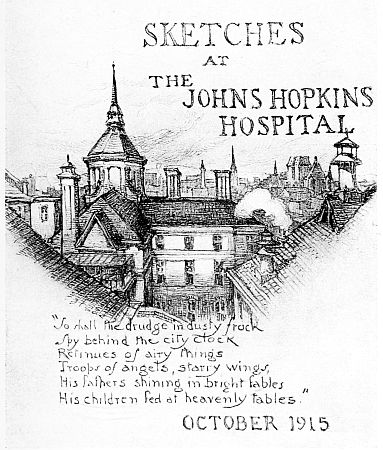
It was one of their happy mornings. They trotted along and sat down together, with no thought that life would ever change much for them; they would only get bigger and not go to school, and it would be always like the holiday; they would always live together and be fond of each other. And the mill with its booming—the great chestnut tree under which they played at house—their own little river, the Ripple, where the banks seemed like home, and Tom was always seeing water-rats while Maggie gathered the purple plumy tops of the reeds which she forgot, and dropped afterwards—above all, the great Floss, along which they wandered with a sense of travel, to see the rushing spring-tide, the awful Eagre, come up like a hungry monster, or to see the Great Ash which had once wailed and groaned like a man—these things would always be just the same to them. Tom thought people were at a disadvantage who lived in any other spot of the globe; and Maggie when she read about Christiana passing "the river over which there is no bridge," always saw the Floss between the green pastures by the Great Ash.
 I
IIt was a very quiet place, as such a place should be, save for the cawing of the rooks who had built their nest among the branches of some tall old trees, and were calling to one another, high up in the air. First one sleek bird, hovering near his ragged house as it swung and dangled in the wind, uttered his hoarse cry, quite by chance as it would seem, and in a sober tone as though he were but talking to himself. Another answered, and he called again, but louder than before; then another spoke and then another; and each time the first, aggravated by contradiction, insisted on his case more strongly. Other voices, silent till now, struck in from boughs lower down and higher up and midway, and to the right and left, and from the tree-tops; and others arriving hastily from the grey church turrets and old belfry window, joined the clamour which rose and fell, and swelled and dropped again, and still went on; and all this noisy contention amidst a skimming to and fro, and lighting on fresh branches, and frequent changes of place, which satirized the old restlessness of those who lay so still beneath the moss and turf below, and the useless strife in which they had worn away their lives.
As I was walking with him last night, he asked me how I liked the good man whom I have just now mentioned? and without staying for my answer told me, that he was afraid of being insulted with Latin and Greek at[9] his own table; for which reason he desired a particular friend of his at the university to find him out a clergyman rather of plain sense than much learning, of a good aspect, a clear voice, a sociable temper, and, if possible, a man that understood a little of backgammon. "My friend," says Sir Roger, found me out this gentleman, who, besides the endowments required of him, is, they tell me, a good scholar, though he does not show it. I have given him the parsonage of the parish; and because I know his value, have settled on him a good annuity for life....
At his first settling with me, I made him a present of all the good sermons which have been printed in English, and only begged of him that every Sunday he would pronounce one of them in the pulpit. Accordingly he has digested them into such a series, that they follow one another naturally, and make a continued system of practical divinity.
As Sir Roger was going on in his story, the gentleman we were talking of came up to us, and upon the Knight's asking him who preached to-morrow, for it was Saturday night, told us, the bishop of St. Asaph in the morning, and Dr. South in the afternoon. He then showed us his list of preachers for the whole year, where I saw with a great deal of pleasure, Archbishop Tillotson, Bishop Saunderson, Dr. Barrow, Dr. Calamy, with several living authors who have published discourses of practical divinity.
Last night I lay at the Swan Inn in Lathbury town. A sad night I had of it! My chamber was warmed fair enough by a fire of sea coal. There was a sweet smell of lavender in the sheets which a hot warming pan had also made comfortable. All this promised well, but Polly had forgot to put my silk night cap into my saddlebags! That vexed me sore! All night I felt I was taking a rheum. Some clodhoppers roystering in the tap room forbade sleep at first and as I am not wont to hear the quarters stricken the Abbey bells roused me at frequent intervals and made me swear roundly. About midnight the Royal Mail rolled over the bridge with a noise fit to wake the Seven Sleepers! The hoof beats of its cattle echoed on the stone walls of the houses like a salute by His Majesty's Footguards! How I ached for my quiet chambers in the Temple. At length I fell to sleep and so sound that when I waked the sun had long been shining through my lattice. I was late in meeting the Squire and the Vicar, and that too after making express this arduous ride. Indeed I was vexed—and I showed it.
The Swan is a venerable and rambling building, stretching itself lazily with outspread arms; one of those inns (long may they be preserved from the rebuilders!) on which one stumbles up or down into every room, and where eggs and bacon have an appropriateness that make them a more desirable food than ambrosia. The little parlor is wainscotted with the votive paintings—a village Diploma Gallery—of artists who have made the Swan their home.
 III
IIIOne almost expects to see a fine green moss all over an inhabitant of Steyning. One day as I passed through the town I saw a man painting a new sign over a shop, a proceeding that so aroused my curiosity that I stood for a minute or two to look on. The painter filled in one letter, gave a huge yawn, looked up and down two or three times as if he had lost something, and finally descended from his perch and disappeared. Five weeks later I passed that way again, and it is a fact that the same man was at work on the same sign. Perhaps when the reader takes the walk I am about to recommend to his attention—a walk which comprises some of the finest scenery in Sussex—that sign will be finished, and the accomplished artist will have begun another; but I doubt it. There is plenty of time for everything in Steyning.
If our old English folk could not get an arched roof, then they loved to have it pointed, with polished timber beams on which the eye rested as on looking upwards through a tree. Their rooms they liked of many shapes, and not at right angles on the corners, nor all on the same dead level of flooring. You had to go up a step into one, and down a step into another, and along a winding passage into a third, so that each part of the house had its individuality. To these houses life fitted itself and grew to them; they were not mere walls, but became part of existence. A man's house was not only his castle, a man's house was himself. He could not tear himself away from his house, it was like tearing up the shrieking mandrake by the root, almost death itself.... Dark beams inlaid in the walls support the gables; the slight curve of the great beam adds, I think, to the interest of the old place, for it is a curve that has grown and was not premeditated; it has grown like the bough of a tree, not from any set human design. This too is the character of the house. It is not large, not overburdened with gables, not ornamented, not what is called striking, in any way, but simply an old English house, genuine and true. The warm sunlight falls on the old red tiles, the dark beams look the darker for the glow of light, the shapely cone of the hop-oust rises at the end; there are swallows and flowers and ricks and horses, and so it is beautiful because it is natural and honest. It is the simplicity that makes it so touching,[17] like the words of an old ballad ... why even a tall chanticleer makes a home look homely. I do like to see a tall proud chanticleer strutting in the yard and barely giving way as I advance, almost ready to do battle with a stranger like a mastiff.
There he lies, Fundator Noster, in his ruff and gown, awaiting the great Examination Day.... Yonder sit some threescore old gentlemen pensioners of the hospital, listening to the prayers and the psalms. You hear them coughing feebly in the twilight,—the old reverend blackgowns.... How solemn the well-remembered prayers are, here uttered again in the place where in childhood we used to hear them! How beautiful, and decorous the rite; how noble the ancient words of the supplications which the priest utters, and to which generations of fresh children and troops of bygone seniors have cried Amen! under those arches! The service for Founder's Day is a special one; one of the psalms selected being the thirty-seventh and we hear—
23. The steps of a good man are ordered by the Lord, and he delighteth in his way—
24. Though he fall, he shall not be utterly cast down, for the Lord upholdeth him with his hand.
25. I have been young and now am old, yet have I not seen the righteous forsaken, nor his seed begging their bread.
Hiram's Hospital, as the retreat is called, is a picturesque building enough, and shows the correct taste with which the ecclesiastical architects of those days were imbued. It stands on the banks of the little river, which flows nearly round the cathedral close, being on the side furthest from the town. The London[21] road crosses the river by a pretty one-arched bridge, and looking from this bridge, the stranger will see the windows of the old men's rooms, each pair of windows separated by a small buttress. A broad gravel walk runs between the building and the river, which is always trim and cared for; and at the end of the walk, under the parapet of the approach to the bridge, is a large and well-worn seat, on which, in mild weather three or four of Hiram's bedesmen are sure to be seen seated. Beyond this row of buttresses, and further from the bridge and also further from the water which here suddenly bends, are the pretty oriel windows of Mr. Harding's house, and his well mown lawn. The entrance to the hospital is from the London road and is made through a ponderous gateway under a heavy stone arch, unnecessary, one would suppose, at any time, for the protection of twelve old men, but greatly conducive to the good appearance of Hiram's charity. On passing through this portal, never closed to any one from six a.m. till ten p.m., and never open afterwards, except on application to a huge, intricately hung mediæval bell, the handle of which no un-initiated intruder can possibly find, the six doors of the old men's abodes are seen, and beyond them is a slight iron screen, through which the more happy portion of the Barchester élite pass into the Elysium of Mr. Harding's dwelling.
He who loves immense space, cloud shadows sailing over purple slopes, island gardens, distant glimpses of snow-capped mountains, breadth, air, immensity, and flooding sunlight, will choose Maggiore. But scarcely has he cast his vote for this, the Juno of the divine rivals, when he remembers the triple lovelinesses of the Larian Aphrodite, disclosed in all their placid grace from Villa Serbelloni;—the green blue of the waters, clear as[25] glass, opaque through depth; the millefleurs roses clambering into cypresses by Cadenabbia; the laburnums hanging their yellow clusters from the clefts of Sasso Rancio; the oleander arcades of Varenna; the wild white limestone crags of San Martino, which he has climbed to feast his eyes with the perspective, magical, serene, Leonardesquely perfect, of the distant gates of Adda. Then while this modern Paris is yet doubting, perhaps a thought may cross his mind of sterner solitary Lake Iseo—the Pallas of the three. She offers her own attractions. The sublimity of Monte Adamello, dominating Lovere and all the lowland like Hesiod's hill of Virtue reared aloft above the plain of common life, has charms to tempt heroic lovers.
The painter may transfer its campanile, glittering like dragon's scales, to his canvas. The lover of the picturesque will wander through its aisle at mass-time, watching the sunlight play upon those upturned Southern faces with their ardent eyes; and happy is he who sees young men and maidens on Whit Sunday crowding round the chancel rails, to catch the marigolds and gillyflowers scattered from baskets which the priest has blessed.
The changes of scene upon this tiny square are so frequent as to remind one of a theatre. Looking down from the inn-balcony, between the glazy green pots gay with scarlet amaryllis-bloom, we are inclined to fancy that the whole has been prepared for our amusement. In the morning the cover for the macaroni-flour, after being washed, is spread out on the bricks to dry. In the afternoon the fishermen bring their nets for the same purpose. In the evening the city magnates promenade and whisper. Dark-eyed women, with orange or crimson kerchiefs for headgear, cross and re-cross, bearing baskets on their shoulders. Great lazy large limbed fellows, girt with scarlet sashes and finished off with dark blue night-caps (for a contrast to their saffron-colored shirts, white breeches and sunburnt calves), slouch about or sleep face downwards on the parapets.
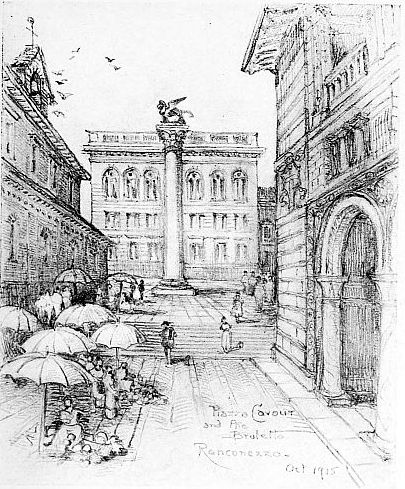 VIII
VIIIHow the hand of Time has mellowed the ruddy brick and the marble's whiteness until ivory and rose blend and are in harmony with those stained and faded frescoes which still remain in the panels of the upper walls. Columns of veined marble stand in ranks on either side of the entrance. They are mounted on the backs of stiff-maned lions. Fit supporters are these for the arches of the Sanctuary as, at its very door, with claw and tooth they tear to pieces the bestial forms of vice and ignorance. Above rise the moulded archivolts, tier on tier, clothed with vine and tendril and peopled with bird and beast. These may be uncouth in form, but the rude hands that fashioned them learned their lesson at the feet of Nature. What there is of convention in arrangement or in pattern has flowed hither through the East from the original fountains of Greece and Rome but now at last all moves in freedom and without restraint. As in the short nights of the North sunrise follows fast upon the setting of the sun, so here though we see in this work the sunset of the Antique yet it is already aglow with light from the coming dawn of Mediæval Art.
Florence is more noisy; indeed, I think it the noisiest town I was ever in. What with the continual jangling of its bells, the rattle of Austrian drums, and the street cries, Ancora mi raccapriccio. The Italians are a vociferous[37] people, and most so among them the Florentines. Walking through a back street one day, I saw an old woman higgling with a peripatetic dealer, who, at every interval afforded him by the remarks of his veteran antagonist, would tip his head on one side, and shout, with a kind of wondering enthusiasm, as if he could hardly trust the evidence of his own senses to such loveliness, O, che bellezza! che belle-e-ezza! The two had been contending as obstinately as the Greeks and Trojans over the body of Patroclus, and I was curious to know what was the object of so much desire on the one side and admiration on the other. It was a half dozen of weazeny baked pears, beggarly remnant of the day's traffic.... It never struck me before what a quiet people Americans are.
The semi-dome of the eastern apse above the high altar is entirely filled with a gigantic half-length figure of Christ. He raises His right hand to bless and with His left holds an open book on which is written in Greek and Latin, "I am the Light of the world." ... Below him on a smaller scale are ranged the archangels and the mother of the Lord, who holds the child upon her knees. Thus Christ appears twice upon this wall, once as the Omnipotent Wisdom, the Word by whom all things were made, and once as God deigning to assume a shape of flesh and dwell with men. The magnificent image of supreme Deity seems to fill with a single influence and to dominate the whole building. The house with all its glory is his. He dwells there like Pallas in her Parthenon or Zeus in his Olympian temple. To left and right over every square inch of the cathedral blaze mosaics, which portray the story of God's dealings with the human race from the Creation downwards, together with those angelic beings and saints who symbolize each in his own degree some special virtue granted to mankind. The walls of the fane are therefore an open book of history, theology and ethics for all men to read.
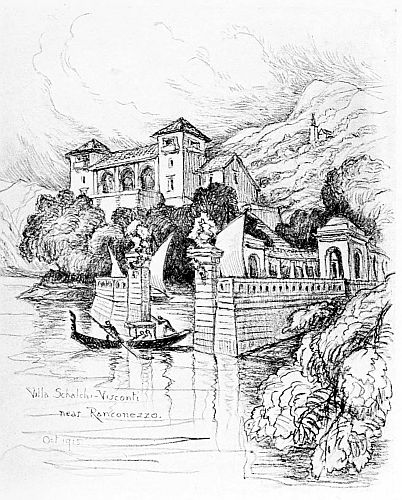 XI
XITruly everything here has a dramatic character. The smallness and grace of this little church gleaming with colour, its chapels and grottoes like a spiritual vision, such as I have never found elsewhere in the whole field of religious conception. It is an illustrated picture-book of poetical legends, which are bloodless and painless, though fantastic, like the lives of pious anchorites in the wilderness, and amid the birds of the field. Here Religion treads on the borders of fairy-land, and brings an indescribable atmosphere away from thence.
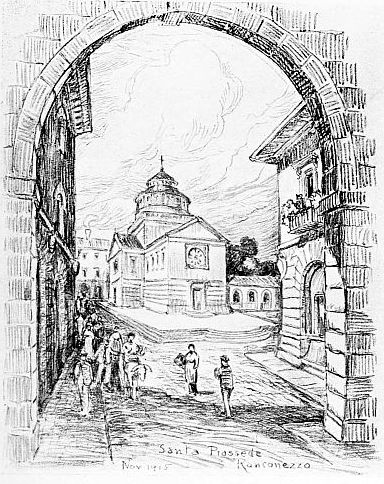 XII
XII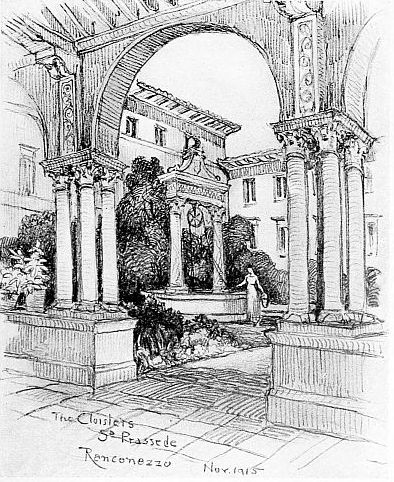 XIII
XIII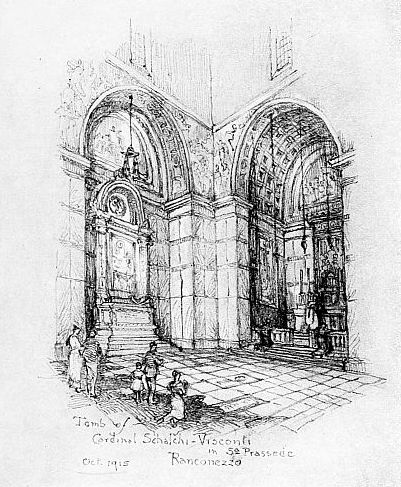 XIV
XIVIt is a drowsy little Burgundian town, very old and ripe, with crooked streets, vistas always oblique, and steep moss-covered roofs.... I carried away from Beaune the impression of something autumnal,—something rusty yet kindly, like the taste of a sweet russet pear.
At Le Mans as at Bourges, my first business was with the cathedral, to which I lost no time in directing my steps.... It stands on the edge of the eminence of the town, which falls straight away on two sides of it, and makes a striking mass, bristling behind, as you see it from below, with rather small but singularly numerous flying buttresses. On my way to it I happened to walk through the one street which contains a few ancient and curious houses,—a very crooked and untidy lane, of really mediæval aspect, honored with the denomination of the Grand Rue. Here is the house of Queen Berengaria.... The structure in question—very sketchable, if the sketcher could get far enough away from it—is an elaborate little dusky façade, overhanging the street, ornamented with panels of stone, which are covered with delicate Renaissance sculpture. A fat old woman, standing in the door of a small grocer's shop next to it,—a most gracious old woman, with a bristling[61] moustache and a charming manner,—told me what the house was.
This admirable house, in the centre of the town, gabled, elaborately timbered, and much restored, is a really imposing monument. The basement is occupied by a linen-draper, who flourishes under the auspicious sign of the Mère de Famille; and above her shop the tall front rises in five overhanging stories. As the house occupies the angle of a little place, the front is double, and carved and interlaced, has a high picturesqueness. The Maison d'Adam is quite in the grand style, and I am sorry to say I failed to learn what history attaches to its name.
I remember going around to the church, after I had left the good sisters, and to a little quiet terrace, which stands in front of it, ornamented with a few small trees and bordered with a wall, breast high, over which you look down steep hillsides, off into the air, and all about the neighboring country. I remember saying to myself that this little terrace was one of those felicitous nooks which the tourist of taste keeps in his mind as a picture.
They wake you early in this hilly town. It was hardly light this morning when up and down through all its highways went a vigorous drum beat. Reluctantly peeking from the window to see the troops enter our square I was disappointed to find that one regimental drummer, marching unaccompanied and lonely, had done all this mischief. What useful purpose did he serve? After a brief respite and repose the noise of another commotion came in with the morning air; a murmur which grew and became a chatter and at last a din! The next journey to the window showed that the morning market was in full swing. Piles of fresh greens and rich-colored vegetables were tended by gnarled old peasant women sitting under widespread umbrellas of faded colors. But what a pleasant air it was that came through the opened sash; a mountain air with just that faint flavor of garlic tinging it which presages something satisfying to be found later. Strengthened for a time by our coffee and rolls we wandered through these winding streets. We saw the weather-beaten, leaden flèche of the cathedral high on the hill, but for the time were satisfied to study the many ancient houses which still remain. Their fronts framed in dark oak with a filling of amber-colored plaster topple over the public ways until they almost meet. Here and there the oak beams are carved, and grinning man or snarling monster regards you from corbel or boss. In places too there are bits of old Gothic detail and one doorway of true Flamboyant work. There is the true poetry of architecture! In England the Decorated Period gives you what is handsome, the Perpendicular what is stately. In France the cathedrals[65] of Paris and of Rheims are splendidly serious and correct; but if in Gothic work you seek imaginative, unrestrained, carelessly free poetry it is to be found in the flowing lines and exuberant fancy of the work of the Flamboyant period.
We found much needed restoration in the hors-d'œuvres, the omelette, the cutlet, the salads and the cheese of déjeuner,—and then followed coffee under the awning of the café. Here we looked out on the Grand Place which had now become sleepy, all signs of the market and its business having disappeared. On it front the Mairie, the Bureau des Postes, the Hôtel du Lion d'Or and various centres of local commerce. We watched our neighbors in the café; the colonel with clanking sword in vigorous discussion with a local magnate; the retired bourgeois who played a desultory game of billiards or a deeply thought out match at dominoes. A quiet square it was now, and, in the shade of its plane trees, comfortable and at peace with the world, we fell asleep and made up for the wakefulness of our earlier hours.
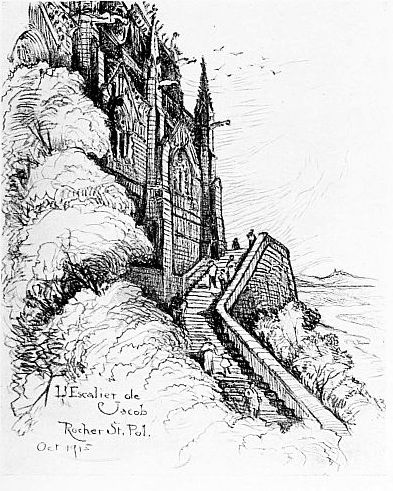 XVII
XVII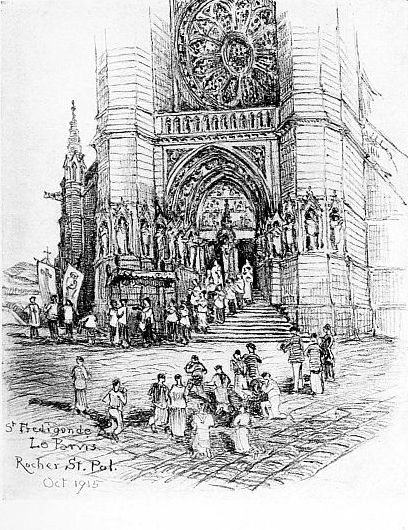 XVIII
XVIIIAll day the sky had been banked with thunderclouds, but by the time we reached Chartres, toward four o'clock, they had rolled away under the horizon, and the town was so saturated with sunlight that to pass into the cathedral was like entering the dense obscurity of a church in Spain. At first all detail was imperceptible: we were in a hollow night. Then, as the shadows gradually thinned and gathered themselves up into pier and vault and ribbing, there burst out of them great sheets and showers of color. Framed by such depths of darkness, and steeped in a blaze of mid-summer sun, the familiar windows seemed singularly remote and yet overpoweringly vivid. Now they widened into dark-shored pools splashed with sunset, now glittered and menaced like the shields of fighting angels. Some were cataracts of sapphires, others roses dropped from a saint's tunic, others great carven platters strewn with heavenly regalia, others the sails of galleons bound for the Purple Islands; and in the western wall the scattered fires of the rose window hung like a constellation in an African night. When one dropped one's eyes from these ethereal harmonies, the dark masses of masonry below them, all veiled and muffled in a mist pricked by a few altar lights, seemed to symbolize the life on earth, with its shadows, its heavy distances and its little islands of illusions. All that a great cathedral can be, all the meanings it can express, all the tranquillizing power it can breathe upon the soul, all the richness of detail it can fuse into a large utterance of strength and beauty, the cathedral of Chartres gave us in that perfect hour.
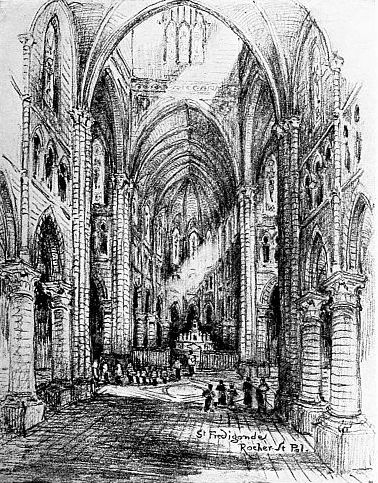 XIX
XIXAll else for which the builders sacrificed, has passed away—all their living interests, and aims, and achievements. We know not for what they labored, and we see no evidence of their reward. Victory, wealth, authority, happiness—all have departed, though bought by many a bitter sacrifice. But of them, and their life and their toil upon the earth, one reward, one evidence, is left to us in those gray heaps of deep-wrought stone. They have taken with them to the grave their powers, their honors, and their errors; but they have left us their adoration.
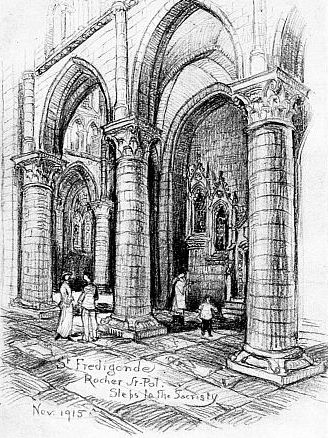 XX
XXWe spent yesterday in the Forêt de C——. As the Emperor had guests we were not admitted at the Château, but we tramped for long through the woods. The grassy roads run beneath the embowering beeches straight from carrefour to carrefour. The gnarled and twisted trunks give to each tree a personal character and make it a master-piece of Nature. Of a sudden we came on the Imperial hunt winding in gay procession through the forest to its rendezvous. Hunting horns in triple rings of brass encircled the leading horsemen. From time to time we heard from them the familiar strains which echo through the Latin Quarter at Mi-Carême. Then followed in brilliant liveries a troop of lackeys, grooms, and other servants, and the pack of staghounds held in leash but sniffing and yelping. Next came the hunters themselves on high-bred mounts and in court costumes of ancient design. Lastly there were barouches and landaus carrying the ladies of the Court "en grande tenue." The sunlight flickering through the beech branches enlivened this brilliant train as it wound through the forest glades and disappeared down a green allée.
We had continued our walk for scarce a mile when, but a short distance from us, a stag crossed our path—stood startled—with head erect,—and then with confident leaps vanished in the forest just as the distant hounds became aware of him and joined in a wild chorus. In a few moments the pack came in a rush across our path. Up the different allées rode the horsemen in haste—asking of us news of the stag. We on foot joined in the pursuit,—but at last the forest[85] swallowed one after the other, stag, and hounds, and hunters, and the sound of dog and horn.
On leaving the forest we passed the small Château. Its conical turret roofs and lofty chimneys, and its flashing finials and girouettes make a brave show above the forest trees. The terraces overlook wide meadow lands through which the river winds until it is lost in the hazy distance.
 XXIII
XXIII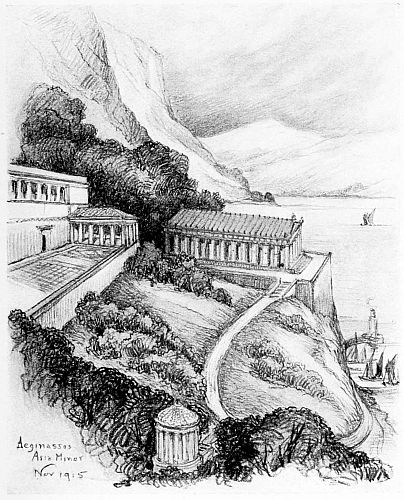 XXIV
XXIVText uses both Aeginossis and Æginassos.
Some illustrations had to be relocated so that they did not interrupt paragraphs or stanzas of poetry. However, the table of contents links to the illustration.
The remaining corrections made are indicated by dotted lines under the corrections. Scroll the mouse over the word and the original text will appear.
End of Project Gutenberg's Hospital Sketches, by Robert Swain Peabody
*** END OF THIS PROJECT GUTENBERG EBOOK HOSPITAL SKETCHES ***
***** This file should be named 35289-h.htm or 35289-h.zip *****
This and all associated files of various formats will be found in:
http://www.gutenberg.org/3/5/2/8/35289/
Produced by Chris Curnow, Emmy and the Online Distributed
Proofreading Team at http://www.pgdp.net (This file was
produced from images generously made available by The
Internet Archive)
Updated editions will replace the previous one--the old editions
will be renamed.
Creating the works from public domain print editions means that no
one owns a United States copyright in these works, so the Foundation
(and you!) can copy and distribute it in the United States without
permission and without paying copyright royalties. Special rules,
set forth in the General Terms of Use part of this license, apply to
copying and distributing Project Gutenberg-tm electronic works to
protect the PROJECT GUTENBERG-tm concept and trademark. Project
Gutenberg is a registered trademark, and may not be used if you
charge for the eBooks, unless you receive specific permission. If you
do not charge anything for copies of this eBook, complying with the
rules is very easy. You may use this eBook for nearly any purpose
such as creation of derivative works, reports, performances and
research. They may be modified and printed and given away--you may do
practically ANYTHING with public domain eBooks. Redistribution is
subject to the trademark license, especially commercial
redistribution.
*** START: FULL LICENSE ***
THE FULL PROJECT GUTENBERG LICENSE
PLEASE READ THIS BEFORE YOU DISTRIBUTE OR USE THIS WORK
To protect the Project Gutenberg-tm mission of promoting the free
distribution of electronic works, by using or distributing this work
(or any other work associated in any way with the phrase "Project
Gutenberg"), you agree to comply with all the terms of the Full Project
Gutenberg-tm License (available with this file or online at
http://gutenberg.net/license).
Section 1. General Terms of Use and Redistributing Project Gutenberg-tm
electronic works
1.A. By reading or using any part of this Project Gutenberg-tm
electronic work, you indicate that you have read, understand, agree to
and accept all the terms of this license and intellectual property
(trademark/copyright) agreement. If you do not agree to abide by all
the terms of this agreement, you must cease using and return or destroy
all copies of Project Gutenberg-tm electronic works in your possession.
If you paid a fee for obtaining a copy of or access to a Project
Gutenberg-tm electronic work and you do not agree to be bound by the
terms of this agreement, you may obtain a refund from the person or
entity to whom you paid the fee as set forth in paragraph 1.E.8.
1.B. "Project Gutenberg" is a registered trademark. It may only be
used on or associated in any way with an electronic work by people who
agree to be bound by the terms of this agreement. There are a few
things that you can do with most Project Gutenberg-tm electronic works
even without complying with the full terms of this agreement. See
paragraph 1.C below. There are a lot of things you can do with Project
Gutenberg-tm electronic works if you follow the terms of this agreement
and help preserve free future access to Project Gutenberg-tm electronic
works. See paragraph 1.E below.
1.C. The Project Gutenberg Literary Archive Foundation ("the Foundation"
or PGLAF), owns a compilation copyright in the collection of Project
Gutenberg-tm electronic works. Nearly all the individual works in the
collection are in the public domain in the United States. If an
individual work is in the public domain in the United States and you are
located in the United States, we do not claim a right to prevent you from
copying, distributing, performing, displaying or creating derivative
works based on the work as long as all references to Project Gutenberg
are removed. Of course, we hope that you will support the Project
Gutenberg-tm mission of promoting free access to electronic works by
freely sharing Project Gutenberg-tm works in compliance with the terms of
this agreement for keeping the Project Gutenberg-tm name associated with
the work. You can easily comply with the terms of this agreement by
keeping this work in the same format with its attached full Project
Gutenberg-tm License when you share it without charge with others.
1.D. The copyright laws of the place where you are located also govern
what you can do with this work. Copyright laws in most countries are in
a constant state of change. If you are outside the United States, check
the laws of your country in addition to the terms of this agreement
before downloading, copying, displaying, performing, distributing or
creating derivative works based on this work or any other Project
Gutenberg-tm work. The Foundation makes no representations concerning
the copyright status of any work in any country outside the United
States.
1.E. Unless you have removed all references to Project Gutenberg:
1.E.1. The following sentence, with active links to, or other immediate
access to, the full Project Gutenberg-tm License must appear prominently
whenever any copy of a Project Gutenberg-tm work (any work on which the
phrase "Project Gutenberg" appears, or with which the phrase "Project
Gutenberg" is associated) is accessed, displayed, performed, viewed,
copied or distributed:
This eBook is for the use of anyone anywhere at no cost and with
almost no restrictions whatsoever. You may copy it, give it away or
re-use it under the terms of the Project Gutenberg License included
with this eBook or online at www.gutenberg.net
1.E.2. If an individual Project Gutenberg-tm electronic work is derived
from the public domain (does not contain a notice indicating that it is
posted with permission of the copyright holder), the work can be copied
and distributed to anyone in the United States without paying any fees
or charges. If you are redistributing or providing access to a work
with the phrase "Project Gutenberg" associated with or appearing on the
work, you must comply either with the requirements of paragraphs 1.E.1
through 1.E.7 or obtain permission for the use of the work and the
Project Gutenberg-tm trademark as set forth in paragraphs 1.E.8 or
1.E.9.
1.E.3. If an individual Project Gutenberg-tm electronic work is posted
with the permission of the copyright holder, your use and distribution
must comply with both paragraphs 1.E.1 through 1.E.7 and any additional
terms imposed by the copyright holder. Additional terms will be linked
to the Project Gutenberg-tm License for all works posted with the
permission of the copyright holder found at the beginning of this work.
1.E.4. Do not unlink or detach or remove the full Project Gutenberg-tm
License terms from this work, or any files containing a part of this
work or any other work associated with Project Gutenberg-tm.
1.E.5. Do not copy, display, perform, distribute or redistribute this
electronic work, or any part of this electronic work, without
prominently displaying the sentence set forth in paragraph 1.E.1 with
active links or immediate access to the full terms of the Project
Gutenberg-tm License.
1.E.6. You may convert to and distribute this work in any binary,
compressed, marked up, nonproprietary or proprietary form, including any
word processing or hypertext form. However, if you provide access to or
distribute copies of a Project Gutenberg-tm work in a format other than
"Plain Vanilla ASCII" or other format used in the official version
posted on the official Project Gutenberg-tm web site (www.gutenberg.net),
you must, at no additional cost, fee or expense to the user, provide a
copy, a means of exporting a copy, or a means of obtaining a copy upon
request, of the work in its original "Plain Vanilla ASCII" or other
form. Any alternate format must include the full Project Gutenberg-tm
License as specified in paragraph 1.E.1.
1.E.7. Do not charge a fee for access to, viewing, displaying,
performing, copying or distributing any Project Gutenberg-tm works
unless you comply with paragraph 1.E.8 or 1.E.9.
1.E.8. You may charge a reasonable fee for copies of or providing
access to or distributing Project Gutenberg-tm electronic works provided
that
- You pay a royalty fee of 20% of the gross profits you derive from
the use of Project Gutenberg-tm works calculated using the method
you already use to calculate your applicable taxes. The fee is
owed to the owner of the Project Gutenberg-tm trademark, but he
has agreed to donate royalties under this paragraph to the
Project Gutenberg Literary Archive Foundation. Royalty payments
must be paid within 60 days following each date on which you
prepare (or are legally required to prepare) your periodic tax
returns. Royalty payments should be clearly marked as such and
sent to the Project Gutenberg Literary Archive Foundation at the
address specified in Section 4, "Information about donations to
the Project Gutenberg Literary Archive Foundation."
- You provide a full refund of any money paid by a user who notifies
you in writing (or by e-mail) within 30 days of receipt that s/he
does not agree to the terms of the full Project Gutenberg-tm
License. You must require such a user to return or
destroy all copies of the works possessed in a physical medium
and discontinue all use of and all access to other copies of
Project Gutenberg-tm works.
- You provide, in accordance with paragraph 1.F.3, a full refund of any
money paid for a work or a replacement copy, if a defect in the
electronic work is discovered and reported to you within 90 days
of receipt of the work.
- You comply with all other terms of this agreement for free
distribution of Project Gutenberg-tm works.
1.E.9. If you wish to charge a fee or distribute a Project Gutenberg-tm
electronic work or group of works on different terms than are set
forth in this agreement, you must obtain permission in writing from
both the Project Gutenberg Literary Archive Foundation and Michael
Hart, the owner of the Project Gutenberg-tm trademark. Contact the
Foundation as set forth in Section 3 below.
1.F.
1.F.1. Project Gutenberg volunteers and employees expend considerable
effort to identify, do copyright research on, transcribe and proofread
public domain works in creating the Project Gutenberg-tm
collection. Despite these efforts, Project Gutenberg-tm electronic
works, and the medium on which they may be stored, may contain
"Defects," such as, but not limited to, incomplete, inaccurate or
corrupt data, transcription errors, a copyright or other intellectual
property infringement, a defective or damaged disk or other medium, a
computer virus, or computer codes that damage or cannot be read by
your equipment.
1.F.2. LIMITED WARRANTY, DISCLAIMER OF DAMAGES - Except for the "Right
of Replacement or Refund" described in paragraph 1.F.3, the Project
Gutenberg Literary Archive Foundation, the owner of the Project
Gutenberg-tm trademark, and any other party distributing a Project
Gutenberg-tm electronic work under this agreement, disclaim all
liability to you for damages, costs and expenses, including legal
fees. YOU AGREE THAT YOU HAVE NO REMEDIES FOR NEGLIGENCE, STRICT
LIABILITY, BREACH OF WARRANTY OR BREACH OF CONTRACT EXCEPT THOSE
PROVIDED IN PARAGRAPH 1.F.3. YOU AGREE THAT THE FOUNDATION, THE
TRADEMARK OWNER, AND ANY DISTRIBUTOR UNDER THIS AGREEMENT WILL NOT BE
LIABLE TO YOU FOR ACTUAL, DIRECT, INDIRECT, CONSEQUENTIAL, PUNITIVE OR
INCIDENTAL DAMAGES EVEN IF YOU GIVE NOTICE OF THE POSSIBILITY OF SUCH
DAMAGE.
1.F.3. LIMITED RIGHT OF REPLACEMENT OR REFUND - If you discover a
defect in this electronic work within 90 days of receiving it, you can
receive a refund of the money (if any) you paid for it by sending a
written explanation to the person you received the work from. If you
received the work on a physical medium, you must return the medium with
your written explanation. The person or entity that provided you with
the defective work may elect to provide a replacement copy in lieu of a
refund. If you received the work electronically, the person or entity
providing it to you may choose to give you a second opportunity to
receive the work electronically in lieu of a refund. If the second copy
is also defective, you may demand a refund in writing without further
opportunities to fix the problem.
1.F.4. Except for the limited right of replacement or refund set forth
in paragraph 1.F.3, this work is provided to you 'AS-IS' WITH NO OTHER
WARRANTIES OF ANY KIND, EXPRESS OR IMPLIED, INCLUDING BUT NOT LIMITED TO
WARRANTIES OF MERCHANTIBILITY OR FITNESS FOR ANY PURPOSE.
1.F.5. Some states do not allow disclaimers of certain implied
warranties or the exclusion or limitation of certain types of damages.
If any disclaimer or limitation set forth in this agreement violates the
law of the state applicable to this agreement, the agreement shall be
interpreted to make the maximum disclaimer or limitation permitted by
the applicable state law. The invalidity or unenforceability of any
provision of this agreement shall not void the remaining provisions.
1.F.6. INDEMNITY - You agree to indemnify and hold the Foundation, the
trademark owner, any agent or employee of the Foundation, anyone
providing copies of Project Gutenberg-tm electronic works in accordance
with this agreement, and any volunteers associated with the production,
promotion and distribution of Project Gutenberg-tm electronic works,
harmless from all liability, costs and expenses, including legal fees,
that arise directly or indirectly from any of the following which you do
or cause to occur: (a) distribution of this or any Project Gutenberg-tm
work, (b) alteration, modification, or additions or deletions to any
Project Gutenberg-tm work, and (c) any Defect you cause.
Section 2. Information about the Mission of Project Gutenberg-tm
Project Gutenberg-tm is synonymous with the free distribution of
electronic works in formats readable by the widest variety of computers
including obsolete, old, middle-aged and new computers. It exists
because of the efforts of hundreds of volunteers and donations from
people in all walks of life.
Volunteers and financial support to provide volunteers with the
assistance they need are critical to reaching Project Gutenberg-tm's
goals and ensuring that the Project Gutenberg-tm collection will
remain freely available for generations to come. In 2001, the Project
Gutenberg Literary Archive Foundation was created to provide a secure
and permanent future for Project Gutenberg-tm and future generations.
To learn more about the Project Gutenberg Literary Archive Foundation
and how your efforts and donations can help, see Sections 3 and 4
and the Foundation web page at http://www.pglaf.org.
Section 3. Information about the Project Gutenberg Literary Archive
Foundation
The Project Gutenberg Literary Archive Foundation is a non profit
501(c)(3) educational corporation organized under the laws of the
state of Mississippi and granted tax exempt status by the Internal
Revenue Service. The Foundation's EIN or federal tax identification
number is 64-6221541. Its 501(c)(3) letter is posted at
http://pglaf.org/fundraising. Contributions to the Project Gutenberg
Literary Archive Foundation are tax deductible to the full extent
permitted by U.S. federal laws and your state's laws.
The Foundation's principal office is located at 4557 Melan Dr. S.
Fairbanks, AK, 99712., but its volunteers and employees are scattered
throughout numerous locations. Its business office is located at
809 North 1500 West, Salt Lake City, UT 84116, (801) 596-1887, email
[email protected]. Email contact links and up to date contact
information can be found at the Foundation's web site and official
page at http://pglaf.org
For additional contact information:
Dr. Gregory B. Newby
Chief Executive and Director
[email protected]
Section 4. Information about Donations to the Project Gutenberg
Literary Archive Foundation
Project Gutenberg-tm depends upon and cannot survive without wide
spread public support and donations to carry out its mission of
increasing the number of public domain and licensed works that can be
freely distributed in machine readable form accessible by the widest
array of equipment including outdated equipment. Many small donations
($1 to $5,000) are particularly important to maintaining tax exempt
status with the IRS.
The Foundation is committed to complying with the laws regulating
charities and charitable donations in all 50 states of the United
States. Compliance requirements are not uniform and it takes a
considerable effort, much paperwork and many fees to meet and keep up
with these requirements. We do not solicit donations in locations
where we have not received written confirmation of compliance. To
SEND DONATIONS or determine the status of compliance for any
particular state visit http://pglaf.org
While we cannot and do not solicit contributions from states where we
have not met the solicitation requirements, we know of no prohibition
against accepting unsolicited donations from donors in such states who
approach us with offers to donate.
International donations are gratefully accepted, but we cannot make
any statements concerning tax treatment of donations received from
outside the United States. U.S. laws alone swamp our small staff.
Please check the Project Gutenberg Web pages for current donation
methods and addresses. Donations are accepted in a number of other
ways including including checks, online payments and credit card
donations. To donate, please visit: http://pglaf.org/donate
Section 5. General Information About Project Gutenberg-tm electronic
works.
Professor Michael S. Hart is the originator of the Project Gutenberg-tm
concept of a library of electronic works that could be freely shared
with anyone. For thirty years, he produced and distributed Project
Gutenberg-tm eBooks with only a loose network of volunteer support.
Project Gutenberg-tm eBooks are often created from several printed
editions, all of which are confirmed as Public Domain in the U.S.
unless a copyright notice is included. Thus, we do not necessarily
keep eBooks in compliance with any particular paper edition.
Most people start at our Web site which has the main PG search facility:
http://www.gutenberg.net
This Web site includes information about Project Gutenberg-tm,
including how to make donations to the Project Gutenberg Literary
Archive Foundation, how to help produce our new eBooks, and how to
subscribe to our email newsletter to hear about new eBooks.